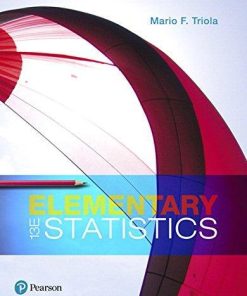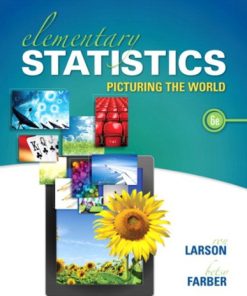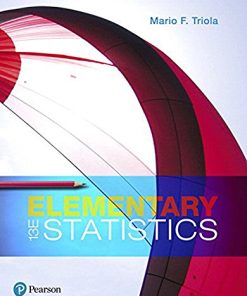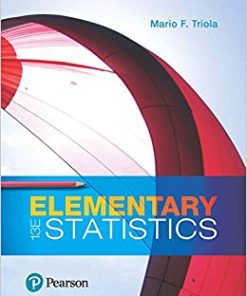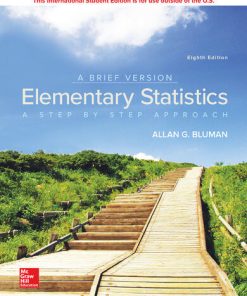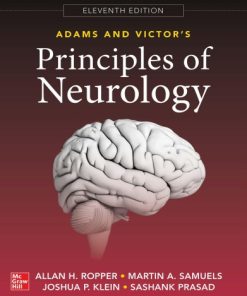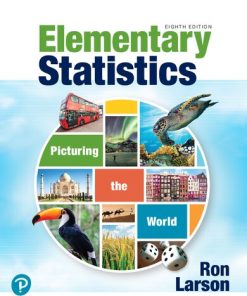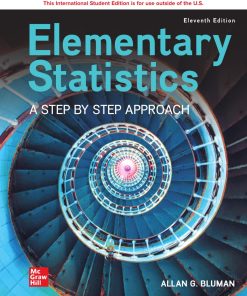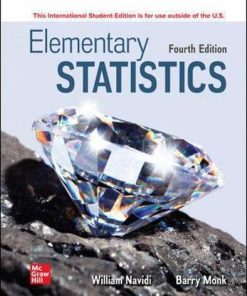Elementary Statistics 11th Edition by Allan Bluman 1260525281 9781260525281
$50.00 Original price was: $50.00.$25.00Current price is: $25.00.
Elementary Statistics 11th Edition by Allan G. Bluman – Ebook PDF Instant Download/DeliveryISBN: 1260525281, 9781260525281
Full download Elementary Statistics 11th Edition after payment.

Product details:
ISBN-10 : 1260525281
ISBN-13 : 9781260525281
Author : Allan Bluman
Elementary Statistics: A Step by Step Approach was written as an aid in the beginning statistics course to students whose mathematical background is limited to basic algebra. The book follows a non-theoretical approach without formal proofs, explaining concepts intuitively and supporting them with abundant examples.
Elementary Statistics 11th Table of contents:
Chapter 1: The Nature of Probability and Statistics
Chapter 1: Introduction
Introduction
1–1 Descriptive and Inferential Statistics
1–2 Variables and Types of Data
1–3 Data Collection and Sampling Techniques
Random Sampling
Systematic Sampling
Stratified Sampling
Cluster Sampling
Other Sampling Methods
1–4 Experimental Design
Observational and Experimental Studies
Uses and Misuses of Statistics
1–5 Computers and Calculators
Summary
Important Terms
Review Exercises
Statistics Today
How Much Do You Owe?—Revisited
Chapter Quiz
Critical Thinking Challenges
Data Projects
Chapter 2: Frequency Distributions and Graphs
Chapter 2: Introduction
Introduction
2–1 Organizing Data
Categorical Frequency Distributions
Grouped Frequency Distributions
2–2 Histograms, Frequency Polygons, and Ogives
The Histogram
The Frequency Polygon
The Ogive
Relative Frequency Graphs
Distribution Shapes
2–3 Other Types of Graphs
Bar Graphs
Pareto Charts
The Time Series Graph
The Pie Graph
Dotplots
Stem and Leaf Plots
Misleading Graphs
Summary
Important Terms
Important Formulas
Review Exercises
Data Analysis
Statistics Today
How Your Identity Can Be Stolen—Revisited
Chapter Quiz
Critical Thinking Challenges
Data Projects
Chapter 3: Data Description
Chapter 3: Introduction
Introduction
3–1 Measures of Central Tendency
The Mean
The Median
The Mode
The Midrange
The Weighted Mean
Distribution Shapes
3–2 Measures of Variation
Range
Population Variance and Standard Deviation
Sample Variance and Standard Deviation
Variance and Standard Deviation for Grouped Data
Coefficient of Variation
Range Rule of Thumb
Chebyshev’s Theorem
The Empirical (Normal) Rule
Linear Transformation of Data
3–3 Measures of Position
Standard Scores
Percentiles
Quartiles and Deciles
Outliers
3–4 Exploratory Data Analysis
The Five-Number Summary and Boxplots
Summary
Important Terms
Important Formulas
Review Exercises
Statistics Today
How Long Are You Delayed by Road Congestion?—Revisited
Data Analysis
Chapter Quiz
Critical Thinking Challenges
Data Projects
Chapter 4: Probability and Counting Rules
Chapter 4: Introduction
Introduction
4–1 Sample Spaces and Probability
Basic Concepts
Classical Probability
Complementary Events
Empirical Probability
Law of Large Numbers
Subjective Probability
Probability and Risk Taking
4–2 The Addition Rules for Probability
4–3 The Multiplication Rules and Conditional Probability
The Multiplication Rules
Conditional Probability
Probabilities for “At Least”
4–4 Counting Rules
The Fundamental Counting Rule
Factorial Notation
Permutations
Combinations
4–5 Probability and Counting Rules
Summary
Important Terms
Important Formulas
Review Exercises
Statistics Today
Would You Bet Your Life?—Revisited
Chapter Quiz
Critical Thinking Challenges
Data Projects
Chapter 5: Discrete Probability Distributions
Chapter 5: Introduction
Introduction
5–1 Probability Distributions
5–2 Mean, Variance, Standard Deviation, and Expectation
Mean
Variance and Standard Deviation
Expectation
5–3 The Binomial Distribution
5–4 Other Types of Distributions
The Multinomial Distribution
The Poisson Distribution
The Hypergeometric Distribution
The Geometric Distribution
Summary
Important Terms
Important Formulas
Review Exercises
Statistics Today
Is Pooling Worthwhile?—Revisited
Chapter Quiz
Critical Thinking Challenges
Data Projects
Chapter 6: The Normal Distribution
Chapter 6: Introduction
Introduction
6–1 Normal Distributions
The Standard Normal Distribution
Finding Areas Under the Standard Normal Distribution Curve
A Normal Distribution Curve as a Probability Distribution Curve
6–2 Applications of the Normal Distribution
Finding Data Values Given Specific Probabilities
Determining Normality
6–3 The Central Limit Theorem
Distribution of Sample Means
Finite Population Correction Factor (Optional)
6–4 The Normal Approximation to the Binomial Distribution
Summary
Important Terms
Important Formulas
Review Exercises
Statistics Today
What Is Normal?—Revisited
Chapter Quiz
Critical Thinking Challenges
Data Projects
Chapter 7: Confidence Intervals and Sample Size
Chapter 7: Introduction
Introduction
7–1 Confidence Intervals
7–2 Confidence Intervals for the Mean When σ Is Known
Sample Size
7–3 Confidence Intervals for the Mean When σ Is Unknown
7–4 Confidence Intervals and Sample Size for Proportions
Confidence Intervals
Sample Size for Proportions
7–5 Confidence Intervals for Variances and Standard Deviations
Summary
Important Terms
Important Formulas
Review Exercises
Statistics Today
Stress and the College Student—Revisited
Data Analysis
Chapter Quiz
Critical Thinking Challenges
Data Projects
Chapter 8: Hypothesis Testing
Chapter 8: Introduction
Introduction
8–1 Steps in Hypothesis Testing—Traditional Method
P-Value Method for Hypothesis Testing
8–2 z Test for a Mean
8–3 t Test for a Mean
8–4 z Test for a Proportion
8–5 χ2 Test for a Variance or Standard Deviation
8–6 Additional Topics Regarding Hypothesis Testing
Confidence Intervals and Hypothesis Testing
Type II Error and the Power of a Test
Summary
Important Terms
Important Formulas
Review Exercises
Statistics Today
How Much Better Is Better?—Revisited
Data Analysis
Chapter Quiz
Critical Thinking Challenges
Data Projects
Chapter 9: Testing the Difference Between Two Means, Two Proportions, and Two Variances
Chapter 9: Introduction
Introduction
9–1 Testing the Difference Between Two Parameters
9–2 Testing the Difference Between Two Means: Using the z Test
9–3 Testing the Difference Between Two Means of Independent Samples: Using the t Test
9–4 Testing the Difference Between Two Means: Dependent Samples
9–5 Testing the Difference Between Proportions
9–6 Testing the Difference Between Two Variances
Summary
Important Terms
Important Formulas
Review Exercises
Statistics Today
To Vaccinate or Not to Vaccinate? Small or Large?—Revisited
Data Analysis
Chapter Quiz
Data Projects
Hypothesis-Testing Summary 1
Chapter 10: Correlation and Regression
Chapter 10: Introduction
Introduction
10–1 Scatter Plots and Correlation
Correlation
10–2 Regression
Line of Best Fit
Determination of the Regression Line Equation
10–3 Coefficient of Determination and Standard Error of the Estimate
Types of Variation for the Regression Model
Residual Plots
Coefficient of Determination
Standard Error of the Estimate
Prediction Interval
10–4 Multiple Regression (Optional)
The Multiple Regression Equation
Testing the Significance of R
Adjusted R 2
Summary
Important Terms
Important Formulas
Review Exercises
Statistics Today
Can Temperature Predict Homicides?—Revisited
Data Analysis
Chapter Quiz
Critical Thinking Challenges
Data Projects
Chapter 11: Other Chi-Square Tests
Chapter 11: Introduction
Introduction
11–1 Test for Goodness of Fit
Test of Normality (Optional)
11–2 Tests Using Contingency Tables
Test for Independence
Test for Homogeneity of Proportions
Summary
Important Terms
Important Formulas
Review Exercises
Statistics Today
Statistics and Heredity—Revisited
Data Analysis
Chapter Quiz
Critical Thinking Challenges
Data Projects
Chapter 12: Analysis of Variance
Chapter 12: Introduction
Introduction
12–1 One-Way Analysis of Variance
12–2 The Scheffé Test, Tukey Test, and Bonferroni Test
Scheffé Test
Tukey Test
Bonferroni Test
12–3 Two-Way Analysis of Variance
Summary
Important Terms
Important Formulas
Review Exercises
Statistics Today
Can Bringing Your Dog to Work Reduce Stress?—Revisited
Data Analysis
Chapter Quiz
Critical Thinking Challenges
Data Projects
Hypothesis-Testing Summary 2
Chapter 13: Nonparametric Statistics
Chapter 13: Introduction
Introduction
13–1 Advantages and Disadvantages of Nonparametric Methods
Advantages
Disadvantages
Ranking
13–2 The Sign Test
Single-Sample Sign Test
Paired-Sample Sign Test
13–3 The Wilcoxon Rank Sum Test
13–4 The Wilcoxon Signed-Rank Test
13–5 The Kruskal-Wallis Test
13–6 The Spearman Rank Correlation Coefficient and the Runs Test
Rank Correlation Coefficient
The Runs Test
Summary
Important Terms
Important Formulas
Review Exercises
Statistics Today
Too Much or Too Little?—Revisited
Data Analysis
Chapter Quiz
Critical Thinking Challenges
Data Projects
Hypothesis-Testing Summary 3
Chapter 14: Sampling and Simulation
Chapter 14: Introduction
Introduction
14–1 Common Sampling Techniques
Random Sampling
Systematic Sampling
Stratified Sampling
Cluster Sampling
Other Types of Sampling Techniques
14–2 Surveys and Questionnaire Design
14–3 Simulation Techniques and the Monte Carlo Method
The Monte Carlo Method
14–4 Big Data
Summary
Important Terms
Review Exercises
Data Analysis
Statistics Today
Let’s Make A Deal—Revisited
Chapter Quiz
Critical Thinking Challenges
Data Projects
People also search for Elementary Statistics 11th:
bluman elementary statistics
elementary statistics textbook
elementary statistics college
elementary statistics examples
elementary statistics with probability
Tags: Elementary Statistics, Allan Bluman, mathematical background, non theoretical approach
You may also like…
Uncategorized
Uncategorized
Uncategorized
Medicine - Neurology
Mathematics - Mathematical Statistics
Elementary Statistics: Picturing the World, 8e 8th Edition Ron Larson
Mathematics - Mathematical Statistics
Elementary Statistics: A Step By Step Approach, 11th/ISE Edition Allan Bluman




